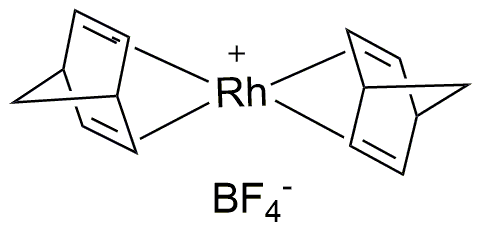Bis(norbornadiene)rhodium(I) tetrafluoroborate is widely utilized in research focused on:
- Catalysis in Organic Synthesis: This compound serves as a highly effective catalyst for various organic reactions, including hydroformylation and carbonylation, enabling the production of valuable chemicals with improved efficiency.
- Coordination Chemistry: It is a key player in coordination chemistry, allowing researchers to explore new metal-ligand interactions and develop novel materials with unique properties.
- Polymerization Processes: The compound is used in polymerization reactions, facilitating the creation of advanced polymers that exhibit enhanced mechanical and thermal properties, beneficial for the plastics industry.
- Pharmaceutical Development: In medicinal chemistry, it aids in the synthesis of complex organic molecules, contributing to the development of new drugs and therapeutic agents.
- Environmental Applications: Its catalytic properties are harnessed in processes aimed at reducing environmental pollutants, making it a valuable tool in green chemistry initiatives.
General Information
Properties
Safety and Regulations
Applications
Bis(norbornadiene)rhodium(I) tetrafluoroborate is widely utilized in research focused on:
- Catalysis in Organic Synthesis: This compound serves as a highly effective catalyst for various organic reactions, including hydroformylation and carbonylation, enabling the production of valuable chemicals with improved efficiency.
- Coordination Chemistry: It is a key player in coordination chemistry, allowing researchers to explore new metal-ligand interactions and develop novel materials with unique properties.
- Polymerization Processes: The compound is used in polymerization reactions, facilitating the creation of advanced polymers that exhibit enhanced mechanical and thermal properties, beneficial for the plastics industry.
- Pharmaceutical Development: In medicinal chemistry, it aids in the synthesis of complex organic molecules, contributing to the development of new drugs and therapeutic agents.
- Environmental Applications: Its catalytic properties are harnessed in processes aimed at reducing environmental pollutants, making it a valuable tool in green chemistry initiatives.
Documents
Safety Data Sheets (SDS)
The SDS provides comprehensive safety information on handling, storage, and disposal of the product.
Product Specification (PS)
The PS provides a comprehensive breakdown of the product’s properties, including chemical composition, physical state, purity, and storage requirements. It also details acceptable quality ranges and the product's intended applications.
Certificates of Analysis (COA)
Search for Certificates of Analysis (COA) by entering the products Lot Number. Lot and Batch Numbers can be found on a product’s label following the words ‘Lot’ or ‘Batch’.
*Catalog Number
*Lot Number
Certificates Of Origin (COO)
This COO confirms the country where the product was manufactured, and also details the materials and components used in it and whether it is derived from natural, synthetic, or other specific sources. This certificate may be required for customs, trade, and regulatory compliance.
*Catalog Number
*Lot Number
Safety Data Sheets (SDS)
The SDS provides comprehensive safety information on handling, storage, and disposal of the product.
DownloadProduct Specification (PS)
The PS provides a comprehensive breakdown of the product’s properties, including chemical composition, physical state, purity, and storage requirements. It also details acceptable quality ranges and the product's intended applications.
DownloadCertificates of Analysis (COA)
Search for Certificates of Analysis (COA) by entering the products Lot Number. Lot and Batch Numbers can be found on a product’s label following the words ‘Lot’ or ‘Batch’.
*Catalog Number
*Lot Number
Certificates Of Origin (COO)
This COO confirms the country where the product was manufactured, and also details the materials and components used in it and whether it is derived from natural, synthetic, or other specific sources. This certificate may be required for customs, trade, and regulatory compliance.


